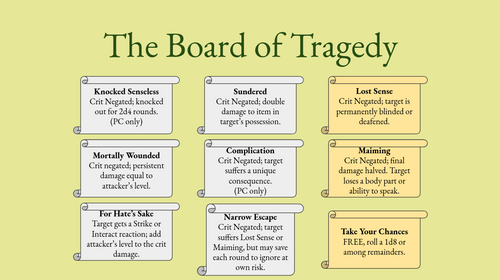The Board of Tragedy

Today is going to be a fairly simple post outlining a house rule I've enjoyed using in Pathfinder 2e: The Board of Tragedy.
This house rule came about because I realized that I've never found a critical hit table I liked. In a game like D&D or Pathfinder, where character advancement is so tied to both your numbers and narrative, the idea of becoming critically maimed in a way you had no way to plan for feels unfair and frustrating. It can be an interesting roleplay challenge, but it can also become comical, especially if the rogue just can't seem to hang onto her ears.
On the other hand, maiming and other complex consequences for combat are a staple of action adventure stories! It feels absurd that we should have no way to implement them.
So, this is my take. The basic idea is to expand the role of Hero Points—that is, their ability to grant players a fraction of the Game Master’s total control over narrative—to allowing players some control over the impact of the rare high moments of play.
This board functions a good deal like a classic critical fumbles deck, with one critical difference: There is no random chance. If this happens to a PC, it's because they made the call.
How Tragedy Unfolds
Whenever a critical hit is scored or a creature critically fails a saving throw against a primarily damage-dealing effect, the player involved (whether they are the attacker or the target) may spend a Hero Point to choose a single card from the Tragedy Board, modifying the normal damage against the card’s effects.
If a critical hit is negated, the triggering attack deals only the amount it would deal on a hit (typically full damage instead of double damage). Any other effects caused by a critical hit or critical failure still occur.
When a card is selected, it is removed from the board for the rest of the arc or adventure. Some cards are removed for even longer, so things don't get silly.
Effects
Knocked Senseless (PC target only)
The critical hit is negated, and the target is knocked unconscious for 2d4 rounds.
Mortally Wounded
The critical hit is negated, and the target takes persistent damage equal to the attacker's level. The persistent damage is of a type appropriate to the attack—usually bleed. The DC to remove the persistent damage is the standard DC for the attacker’s level.
For Hate’s Sake
Before taking damage, the target may make a Strike or use an Interact action as a reaction. Add the attacker’s level to the damage after doubling it. This card is not reshuffled until the end of the current adventure or arc.
Sundered
The critical hit is negated, and the attacker chooses an important item in the target’s possession. That item takes double damage, applying hardness as normal. The GM may choose an item the attacker did not know about.
Complication (PC target only)
The critical hit is negated, and the target suffers a unique consequence of the GM's choosing. Examples might include being hit on the head and losing memories, or an NPC ally interposing themselves between the target and the attacker and taking double damage. The consequence might be quite indirect, such as the target’s frightening near-miss causing a rift to form between them and a lover, but it should be extremely undesirable.
Narrow Escape (PC target only)
The critical hit is negated, and the target suffers the effects of either Lost Sense or Maiming, attacker’s choice. Unlike those cards, though, the effects are not permanent, and only last until the target receives long-term healing. Each round, the target may roll a Fortitude save against a standard DC for the attacker’s level. On a success, they suppress the effects, continuing to act as normal. On two failures or a critical failure, the effects become permanent.
Lost Sense
The critical hit is negated, and the target becomes permanently either blinded or deafened, whichever feels more fitting. If they later spend Downtime becoming acclimated to their new senses, they may remove this condition, but remain respectively either blind or deaf. See Social Splash Damage for more information on adjudicating the effects of this change. This card is not returned to the board.
Maiming
The critical hit is negated, and the final damage is halved. The target either loses a body part of the attacker’s choice or loses the ability to speak. See Characters with Disabilities for more information on the effects of this change. This card is not returned to the board.
Tips & Notes
- Traditionally, the Tragedy Board would be represented by a cork board with cards on it, but you can get away with putting it on a screen instead. That's what I do. Who can afford tragic cork boards in this economy?
- You might choose to swap in "cards" of your own! Even rereading this to post it, I realize I don't have any coverage of "minor maimings" like losing a finger or earning a really cool-looking scar.
- You can also employ these cards for drastic falls. In this case, when the critical would be negated, the fall damage is simply halved.
- I'm not a huge fan of the "roll randomly" option, for obvious reasons. If you don't like it, or don't want it to be abused, I recommend making it once-per-campaign at most.
- In my campaign, the rogue invoked Complication. I told them to grab the Soulforger archetype next level and now they have a headmate. I can't explain exactly why because some of my players read this blog. :)
- I actually think a huge driver of this project was wanting a mechanic for "you get knocked out briefly but might wake up later in time to rejoin the fight". That's Knocked Senseless, of course.
Anyhoo
I'm curious about what people think! Do you use any kind of alternate criticals house rule in your games? What games do you think make randomized injuries really fun or effective (or the opposite)?
cattail kobold's blog
what's she on about this time
| Status | In development |
| Category | Physical game |
| Author | cattail-kobold |
| Tags | blog, Indie, LGBTQIA, Tabletop role-playing game |
More posts
- Fueling the Fire: Prompting Conversations in the DarkFeb 02, 2025
- hi and hello!Feb 02, 2025

Comments
Log in with itch.io to leave a comment.
This is neat! Making it dependent on hero points for both offense and defense feels clever
Thanks! I've only had the chance to test it out once, but it's led to some very fun developments so far!